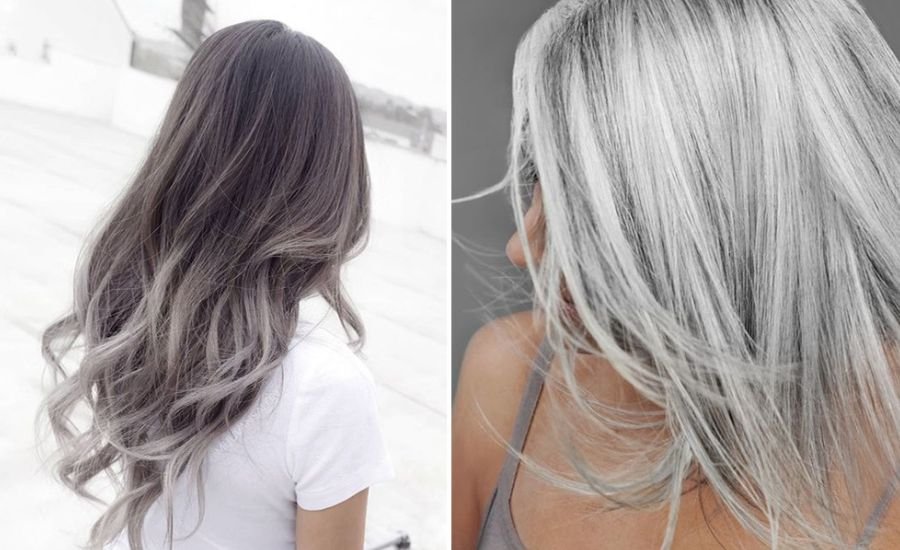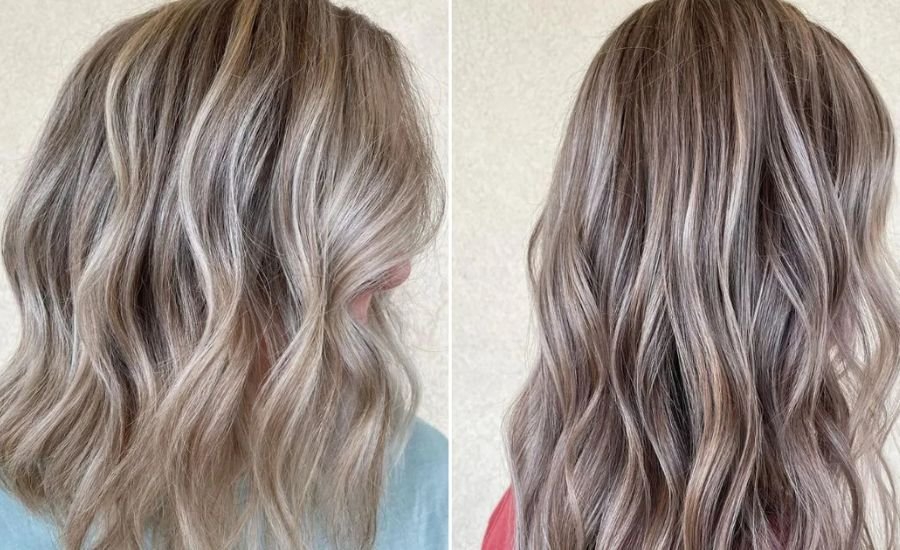Searching for the best hair color to cover gray? Whether your graying locks consist of just a few strands or require more substantial coverage, finding the right hue is essential for achieving a youthful and natural look. From hybrid coloring techniques that blend highlights with all-over coverage to single-process methods, there’s a perfect solution for vibrant, long-lasting results. Discover the best hair color to cover gray and explore top options and tips below to keep your gray beautifully hidden!
What Is Hybrid Hair Color?
Hybrid hair color is an innovative method that utilizes multiple coloring methods in tandem to achieve more natural-looking, multidimensional highlights. This approach blends rich single-process color with texture-driven highlights for an appealing layered hue that helps cover gray hair without creating harsh lines like traditional coloring methods may. Hybrid coloring methods have quickly become an alternative option among those wanting a subtle way to transition away from their gray locks without the harsh lines left by traditional methods of coloring hair.
As more individuals embrace graying locks, hybrid color techniques have become a more appealing solution to provide seamless coverage while still producing an authentic and natural-looking result. This method provides flexibility, offering both full coverage and dimension, which is essential for a realistic gray hair transformation.
Why Is My Hair Turning Gray?
Gray hair can be considered part of the normal aging process; however, genetics, lifestyle choices, and environmental considerations also play a part. Over time, our bodies produce less melanin which controls its color in our hair follicles, ultimately leaving hair without its vibrant hue – eventually turning gray or white as we age! Melanin also plays an essential role in skin pigmentation; therefore affecting everything from our complexions and eyesight to skin health and hair growth.
Causes of Gray Hair: Genetics and Lifestyle.
Genetics plays a pivotal role in when and how quickly your hair will gray, with parents or grandparents who experienced early graying likely experiencing similar experiences themselves. Lifestyle factors, like stress, poor nutrition, and smoking can hasten this process; for instance, a deficiency of certain vitamins such as B12 may even accelerate it further.
Melanin Reduction and Aging Process
Melanin production decreases with age and as hair follicles stop producing pigment, gray hair begins to emerge. The process can start during your late 20s or early 30s due to genetic influences; understanding its mechanism will enable you to select an effective hair color to cover gray, helping maintain youthful looks without harsh color lines.
Best Techniques for Coloring Gray Hair

Hybrid Hair Color: A Modern Solution
Hybrid hair color has quickly become one of the go-to solutions for effectively covering gray hair, as it combines both single-process color’s even coverage and subtle highlights for dimension and texture. Hybrid color helps you achieve a seamless blend between your natural hair and what is being colored, providing seamless gray coverage without noticeable lines or regrowth.
Combining Single-Process Color with Highlights
One of the major advantages of hybrid hair color is that it combines single-process and highlight techniques, creating a sun-kissed effect. Additionally, hybrid coloring works wonders at covering gray as it adds layers that mimic natural variations found in healthy, youthful locks. The highlights break up the solid color, making the transition from gray to colored hair appear much more natural.
Benefits of Dimension and Softness
Hybrid color techniques also provide softness and dimension, which is essential when covering gray. Gray hair tends to be coarse or wiry, making hybrid coloring methods the best solution to soften its coarseness while adding smoothness and shine. By customizing their approach and color techniques accordingly, hybrid techniques offer customized treatments to soften their appearance while adding depth for an enhanced natural beauty look.
Traditional Methods for Gray Coverage
Though hybrid hair color techniques have grown increasingly popular, traditional methods still deliver excellent results in covering gray strands. All-over coloring and highlights remain reliable solutions when looking to cover gray hair strands.
All-Over Color
All-over color is the most straightforward method for covering gray hair. By applying a single shade of color from root to tip, you can fully cover gray hair and restore your natural hair color. This method works best for those who want a uniform, solid color. However, it can require more frequent touch-ups, especially as the gray hair starts to grow back.
Highlights and Balayage for a Natural Look
Highlights and balayage offer great ways to soften a harsh line between gray hairs and colored ones without creating stark transitions between them, creating more natural-looking styles through lighter or darker streaks that blend gray strands seamlessly with color strands. It can help gradually transition towards full head colors without making an immediate commitment.
Finding The Appropriate Hair Color Options
Considerations when Selecting an Insurance Car Plan
When choosing the ideal hair color to cover gray, several factors need to be taken into consideration. Your skin tone, natural hair color, and maintenance preferences all play an essential part in helping determine which shade works best.
Skin Tone: Warm Vs Cool Undertones
At the core of finding your ideal color lies understanding your skin tone. People with warm undertones usually do well when opting for warm hues like honey blonde, caramel, and golden brown; those with cool undertones might prefer shades such as ash blonde, platinum,m, or silver to complement their complexion more efficiently.
Matching Your Natural Hair Color
If you’re uncertain where to start when coloring your hair, one approach that may prove effective is matching its shade to that of natural tresses. Doing this will create an unbroken transition between natural hair color and what you are adding; which can be particularly important when covering gray. Having close hues to nature will also lessen regrowth issues and extend the time between touch-up sessions.
Personal Style and Maintenance Needs
Consider your personal style and maintenance commitment before selecting an ideal hair color to cover gray hair. Some hues require frequent touch-ups while natural browns or blondes might be easier to maintain.
Popular Hair Color Shades for Gray Coverage
There are many shades to choose from when covering gray hair, but some are particularly popular for their ability to blend well with gray strands.
Warm Tones: Honey Blonde, Caramel
Warm tones can be the ideal option for people with yellow or peach undertones in their skin, as honey blonde and caramel hues help brighten up complexions while effectively hiding gray locks. These shades add richness and depth, creating a youthful, radiant look.
Cool Tones: Ash Blonde, Silver
Cool tones like ash blonde and silver are best for people with cool undertones in their skin, providing a sleek and sophisticated appearance as the graying process proceeds naturally. Silver, in particular, is an increasingly popular choice for those stylishly embracing their gray hair.
Bold Choices: Red, Deep Brown
If you’re looking for a more dramatic change, bold colors like deep brown or vibrant red can be an excellent option for covering gray. These shades add intensity and dimension, making your hair stand out while effectively hiding gray strands.
Professional vs. DIY Gray Hair Coloring
Advantages of Professional Coloring
Professional hair colorists have the expertise and tools to provide the best hair color to cover gray. They can customize the color to suit your skin tone, hair texture, and personal preferences, ensuring that the results are flawless and long-lasting.
Expertise in Custom Blending
One of the biggest advantages of professional coloring is the ability to create a custom blend that matches your exact needs. A professional colorist will assess your hair type, natural color, and desired look to create a shade that complements you perfectly.
Precision Application for Long-Lasting Results
Professional colorists are skilled at applying color evenly, ensuring that your hair is fully covered without any patchy spots. They also use high-quality products that help the color last longer and look more vibrant.
DIY Hair Coloring Tips
For those who prefer to color their hair at home, DIY kits can be an affordable and convenient option. However, achieving professional results requires careful application and the right products.
How to Apply Color Evenly at Home
To ensure even coverage when coloring your hair at home, start by dividing your hair into sections. Apply the color evenly from root to tip, making sure to cover every strand of gray hair. Use a tint brush for precise application, and follow the instructions on the product for the best results.
Recommended At-Home Kits for Gray Coverage
When selecting a DIY hair color kit, look for one specifically designed for gray coverage. These kits usually contain stronger formulas that can fully cover gray hair, providing long-lasting results. Choose a color that matches your natural shade for the most seamless look.
Maintenance and Aftercare for Colored Hair
Extending the Life of Your Hair Color
To keep your color looking fresh and vibrant, it’s important to use color-safe products and follow proper aftercare.
Using Color-Safe Products
Shampoos and conditioners designed for color-treated hair help preserve the vibrancy of your color and prevent it from fading. Look for sulfate-free products, as sulfates can strip color from your hair.
Washing and Conditioning Tips
Wash your hair with lukewarm water to prevent color from fading. Avoid hot water, as it can open the hair cuticle and cause color to wash out more quickly. Condition your hair regularly to keep it soft and hydrated.
Minimizing Damage
Colored hair can be more prone to damage, so it’s important to take steps to protect it.
Avoiding Heat Styling
Excessive use of heat styling tools can cause color to fade and damage your hair. Try to limit the use of flat irons, curling irons, and blow dryers, and always apply a heat protectant before styling.
Weekly Deep Conditioning Treatments
Deep conditioning treatments can help restore moisture and prevent damage. Use a nourishing mask once a week to keep your hair healthy and shiny.
Tips for a Successful Gray Hair Transformation

Preparing for Your First Coloring Session
If you’re new to coloring your hair, it’s important to prepare for your first session.
Consultation with a Professional
Before coloring your hair, consult with a professional colorist to discuss your goals and get advice on the best color for your hair type and skin tone. They can help you select the best hair color to cover gray and ensure that you achieve the desired results.
Bringing Inspiration Photos
Bringing photos of the color you want can help your stylist understand exactly what you’re looking for. It also gives them a reference point for the type of coverage and style you want to achieve.
Managing Expectations
Understanding the Process
Coloring gray hair can be a multi-step process, especially if you’re transitioning from dark to light colors. It’s important to understand that it may take several sessions to achieve the look you want.
Achieving a Seamless Transition
When covering gray hair, it’s important to be patient and allow your colorist to gradually transition your hair to the desired shade. This will help ensure a seamless, natural-looking result.
Conclusion
In conclusion, finding the best hair color to cover gray is all about choosing a shade that makes you feel happy and confident. Whether you go for a professional color treatment or try coloring your hair at home, it’s important to pick a color that matches your skin tone and style. Don’t forget to take care of your colored hair with the right products and treatments, so it stays shiny and healthy!
Remember, covering gray hair doesn’t have to be hard. With the right techniques, colors, and a little patience, you can keep your hair looking fresh and vibrant. Whether you prefer a natural look with highlights or a bold new color, the best hair color to cover gray makes you feel great every day.
FAQs
Q: What is the best hair color to cover gray?
A: The best hair color to cover gray depends on your skin tone and personal style. Popular choices include warm tones like honey blonde, cool tones like ash blonde, and deeper shades like dark brown.
Q: Can I color my hair at home to cover gray?
A: Yes, you can use at-home hair dye kits, but it’s important to follow the instructions carefully. For the best results, choose a color that matches your natural shade.
Q: How long does hair color last on gray hair?
A: Hair color typically lasts 4 to 6 weeks, depending on the type of dye used and how often you wash your hair. Using color-safe products can help it last longer.
Q: Can hybrid hair color help cover gray?
A: Yes, hybrid hair color combines single-process color with highlights, offering natural-looking coverage and added dimension to gray hair.
Q: Is it better to go to a professional for gray coverage?
A: A professional can give you precise color application and ensure your gray hair is fully covered. They also provide expert advice on the best color for your hair type.
Q: How can I maintain my color after covering gray?
A: To maintain your color, use color-safe shampoos and conditioners, avoid excessive heat styling, and schedule regular touch-ups to keep your gray hair covered.
Q: Can gray hair be completely covered with color?
A: Yes, gray hair can be fully covered with the right color, especially with professional coloring techniques that blend the color seamlessly with your natural hair.
Return To Homepage

